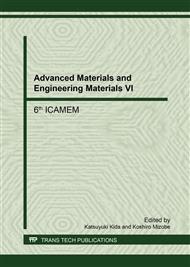p.295
p.301
p.311
p.316
p.323
p.328
p.333
p.341
p.346
Effect of Carbon Dioxide Curing on Strength Development of Cement Mortar
Abstract:
This study was conducted to assess the acceleration of strength development by CO2 curing and to evaluate the strength and microstructure of two cement mortars. Three curing pressures (1, 5, 8 bars), three curing time (20, 120, 180 minutes) and four CO2 concentration (0%, 25%, 50% and 100%) were used in this investigation. Two mortar specimens are made with Type Ι Portland cement and oil-well cement. After the CO2 curing duration and demolding, the mortar samples were assessed through the mass gain, the compressive strength, the pressure drop, the temperature rise in the curing chamber, and the microstructure characteristics. The performance of the CO2 cured mortars was found through the measurement of pressure drop, temperature rise, strength development, mass gain and carbonation. In general, higher CO2 concentration, longer carbonation time, higher CO2 pressure could increase the compressive strength of the mortar and promote more CO2 absorption. The better results obtained from this study are the Type 1 cement mortars curing three hours under 5-bar pressure with 100% CO2 concentration using one-time supply method. The three-hour mortar samples had a high percent strength development. The increasing of CO2 concentration results in higher carbonation degree of mortar, more mass gain, and a stiffer and denser material.
Info:
Periodical:
Pages:
323-327
Citation:
Online since:
August 2017
Authors:
Keywords:
Price:
Сopyright:
© 2017 Trans Tech Publications Ltd. All Rights Reserved
Share:
Citation:


